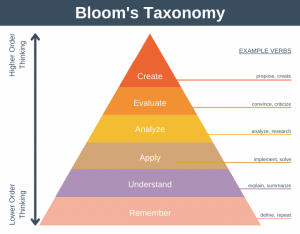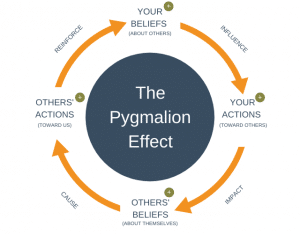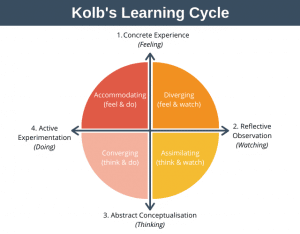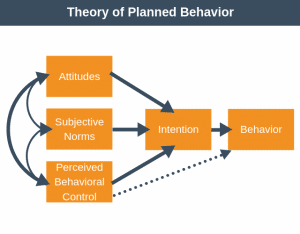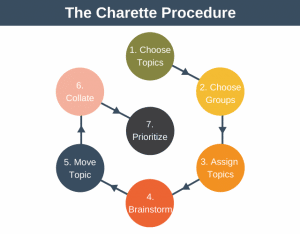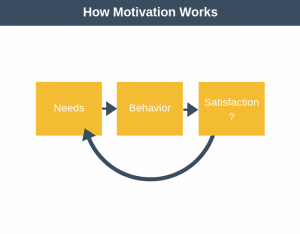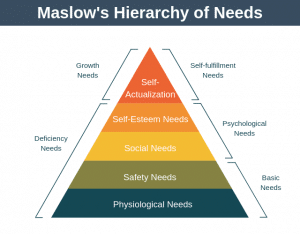The COIN feedback model is a four-step template for giving positive and constructive feedback.
Giving feedback is a critical skill for any team leader, but it can be tricky to deliver effectively. Give feedback that’s too harsh, or say the wrong thing in the spur of the moment, and you could damage your relationship permanently.
Conversely, give feedback that’s too timid, and you may find that the person’s behavior and performance doesn’t improve as hoped.
Feedback is even more difficult to deliver if you feel uncomfortable, anxious, or nervous.
The COIN feedback model sometimes called the COIN conversation model, is a simple framework that you can use to plan your feedback in a constructive, positive, and non-confrontational way.
Background
The COIN feedback model was first described by executive coach and organizational consultant Anna Carroll in her book The Feedback Imperative: How to Give Everyday Feedback to Speed Up Your Team’s Success.
Why is Feedback Important?
Learning to master feedback will help your team reach its goals more quickly. But in addition to that, it can bring many benefits, including that it:
- Builds trust.
- Grows individual and organizational performance.
- Makes your people feel valued.
- Helps create a culture of feedback.
- Clarifies expectations.
- Builds an open and honest culture.
- Improves retention.
The COIN Feedback Model
The COIN feedback model is a four-step process for providing individual feedback, with each step followed in turn. The four steps are:
- Context.
- Observation.
- Impact.
- Next Steps.
One of the big advantages of the model is that it keeps your feedback constructive and stops you from getting sidetracked when you’re trying to deliver an important message.
By keeping your feedback concise and focused, you speed up the communication process as there is less space for misunderstandings.
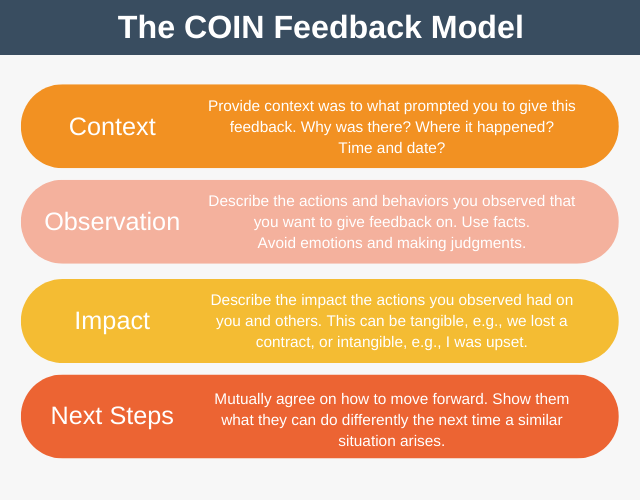
Let’s examine each of the steps in turn.
1. Context
Begin your feedback by providing context as to what prompted you to give this feedback. Describe the situation in which the event took place. Include additional details such as the circumstances around what happened, who was there, where it happened, and the time and date it happened.
You will sometimes see this step of the COIN feedback model referred to as Connection. This is to place greater emphasis on empathizing and connecting with the person you are providing the feedback to.
2. Observation
The second step of the model is to describe the actions or behaviors you want to give feedback on. This should be a specific action or behavior that you actually observed.
Describe what you observed factually, and avoid using emotional language, making judgments, or describing how the actions made you feel.
3. Impact
The third step of the model is to describe the effect their actions had on you and others.
This is crucial in helping the individual understand how their actions have affected others. Without understanding how their actions have negatively affected others, they are less likely to change their future actions and behaviors.
You can describe the impact of their actions in a tangible way (such as losing a contract) or an intangible way (such as upsetting a team member).
4. Next Steps
Now that the individual understands the impact of their actions or behaviors, the final step is to mutually agree on how to move forward. In other words, you need to agree jointly on the next steps.
During this step, you need to help them to see how they should have acted and what they can do differently the next time a similar situation arises.
Unlocking the COIN Model
Knowing what words to use during each stage of the model will make the model much easier for you to use.
So let’s look at the words and phrases commonly used to introduce each phase of the model.
The Context stage of the model often begins with phrases like:
- “At the team meeting yesterday…”
- “On our Zoom call this morning…”
The Observation stage of the model often begins with phrases like:
- “I noticed that you…”
- “When you said…”
- “What I saw was…”
The Impact stage of the model often begins with phrases like:
- “The impact of all that was…”
- “It caused the team to feel…”
- “I felt…”
- “The result was…”
The Next Step stage of the model often begins with phrases like:
- “Next time this happens, I think it would be better to…”
- “What I would like you to do going forward is…”
- “My preference would have been…”
- “My advice would be to…”

COIN Feedback Model Example
Let’s look at an example of using the model in an office environment to cement how to use the model.
For this example, imagine you manage a small team that you are trying to shape into a high-performance team. Yesterday, in a team meeting, you observed one of your team members mock and ridicule another team member who was absent from the meeting. You think this behavior was unprofessional, and you decide to use the COIN model to prepare for a feedback meeting to get them back on the right track.
You’re rough notes that you prepare for the meeting might look something like this:

Context:
- At the team meeting yesterday, I noticed something that I want to talk to you about.
- What I am trying to do here is create a high-performance team.
- I know that one day you’d like to manage your own team.
Observation:
- I noticed that you ridiculed a team member.
- It wasn’t just a one-off quip; you did it three times.
Impact:
- The result of this was that some of the team laughed at what you said. But the rest of the group felt uncomfortable and embarrassed.
- It frustrates me because that just isn’t the behavior you’d expect from a high-performing team.
- Behaviors like that make it difficult for me to hit my objective of creating a high-performance team, which disappoints me.
- It makes each team member worry about what you might say about them the next time they are absent. How would you feel if you knew other people were speaking about you this way?
Next Steps:
- What I’d like you to do going forward is keep these thoughts to yourself.
Pro Tips
Here are some feedback tips which you can use alongside the COIN feedback model to help you give great feedback:
- Give your feedback promptly. Your feedback is no longer timely and relevant if it’s about an event that happened months ago.
- Small nuggets of feedback work better than dropping a massive bombshell of feedback once in a blue moon. This allows the recipient of the feedback to regularly make minor frequent course corrections to their actions and behavior and is much easier to accept than being asked to make huge changes to your behavior.
- If you’re giving negative feedback to a person, do so in private.
- Giving positive feedback in public is a good idea as it allows the individual to bask in the glow of approval from their colleagues.
- Keep your feedback on one or two specific events. Remember that your feedback aims to help someone improve, and providing too much to work on will make this less likely.
COIN Feedback Model Template
If you’d like to use COIN to help with your feedback, you can download our COIN feedback model template to help you here.
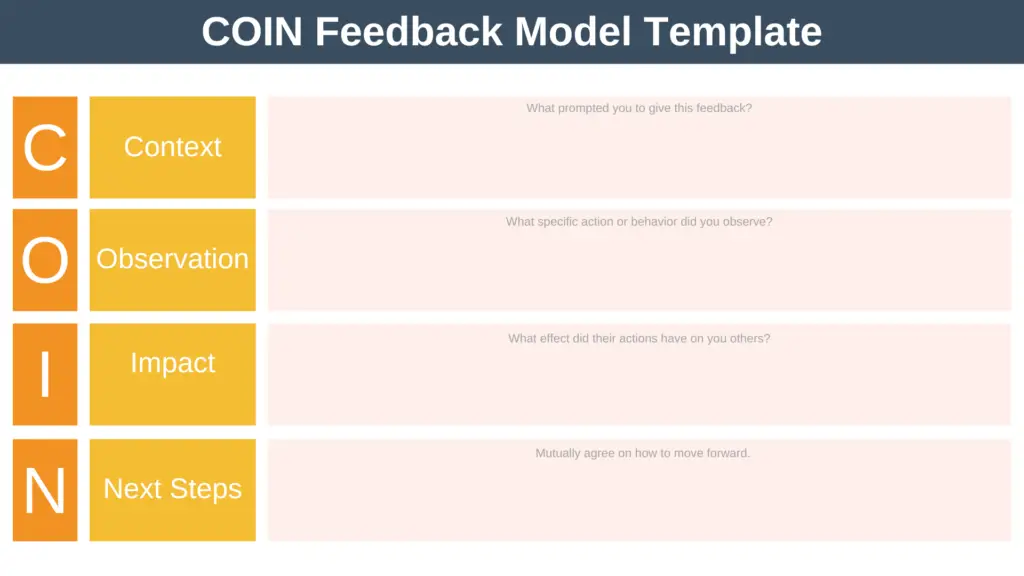
Summary
Giving effective feedback is a critical skill for any team leader. The COIN feedback model is a simple framework that you can use to plan your feedback in a constructive, positive, and non-confrontational way.
By using the COIN feedback model, you create less opportunity for misunderstanding because you’re being very precise about what happened, how it made people feel, and what you’d like them to do next.
